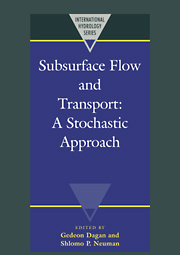Book contents
- Frontmatter
- Contents
- List of contributors
- Preface
- Acknowledgments
- I INTRODUCTION
- II SUBSURFACE CHARACTERIZATION AND PARAMETER ESTIMATION
- III FLOW MODELING AND AQUIFER MANAGEMENT
- 1 Groundwater flow in heterogeneous formations
- 2 Aspects of numerical methods in multiphase flows
- 3 Incorporating uncertainty into aquifer management models
- IV TRANSPORT IN HETEROGENEOUS AQUIFERS
- V FRACTURED ROCKS AND UNSATURATED SOILS
- VI A VIEW TO THE FUTURE
1 - Groundwater flow in heterogeneous formations
Published online by Cambridge University Press: 04 December 2009
- Frontmatter
- Contents
- List of contributors
- Preface
- Acknowledgments
- I INTRODUCTION
- II SUBSURFACE CHARACTERIZATION AND PARAMETER ESTIMATION
- III FLOW MODELING AND AQUIFER MANAGEMENT
- 1 Groundwater flow in heterogeneous formations
- 2 Aspects of numerical methods in multiphase flows
- 3 Incorporating uncertainty into aquifer management models
- IV TRANSPORT IN HETEROGENEOUS AQUIFERS
- V FRACTURED ROCKS AND UNSATURATED SOILS
- VI A VIEW TO THE FUTURE
Summary
INTRODUCTION
Heterogeneity and uncertainty
Hydrogeologic research in the early seventies emphasized the development and solution of equations that describe the flow of water and the transport of chemicals in geologic formations. It was often maintained that the only obstacles to achieving exact predictions of flow and transport were inadequate process understanding and imprecise and inefficient methods of solution. Stochastic methods in the minds of most hydrogeologists were inextricably linked with empirical statistical models, as in time-series analysis, and consequently inappropriate for subsurface hydrology where the physical and chemical processes are well defined and scientifically studied. Significant progress was then made, and continues to be made, in describing the hydrodynamics of flow in geologic media and the physicochemical transport of soluble and insoluble substances.
Yet, the seventies also witnessed the birth and growth of stochastic groundwater hydrology. As deterministic models were applied in practice, and as the focus switched from problems of resource development to problems of decontamination, it became obvious that medium heterogeneity presented a major roadblock to making accurate predictions of flow and transport (Freeze, 1975; Anderson, 1979). The heterogeneity of the hydrogeologic parameters is so complex and difficult to describe quantitatively that even when the physical process is well understood, as is the Darcian process of saturated flow in a sand, it is impossible to predict deterministically the advective transport of a solute plume in the field. field. Heterogeneity can be found at all scales, from the Darcy or laboratory (less than a meter) scale to the field (−100 m) and the regional (kilometer) scale.
Information
- Type
- Chapter
- Information
- Subsurface Flow and TransportA Stochastic Approach, pp. 83 - 91Publisher: Cambridge University PressPrint publication year: 1997
Accessibility standard: Unknown
Why this information is here
This section outlines the accessibility features of this content - including support for screen readers, full keyboard navigation and high-contrast display options. This may not be relevant for you.Accessibility Information
- 7
- Cited by
